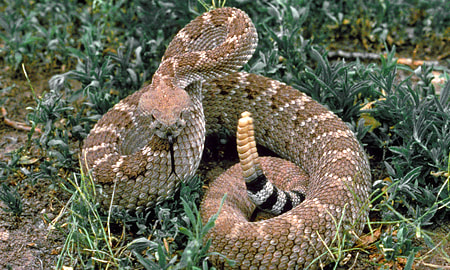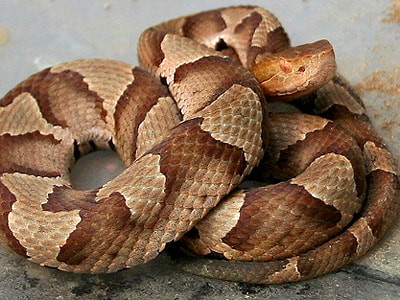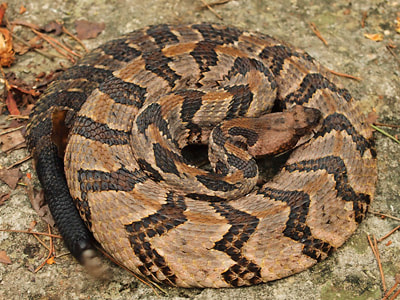Venomous Snakes in Texas
The Lone Star State is home to at least 15 dangerous snake species. Some of the most venomous snakes in Texas are the cottonmouth, the copperhead, the western rattlesnake, the timber rattlesnake, and the coral snake. However, in Texas you can also come across some non-venomous snakes that look similar to their venomous relatives; some of them even emit a rattling sound. For example, the venomous coral snake and the milk snake look remarkably alike. Texas snakes have a critical role to play in the ecosystem, and not all snakes are harmful to humans. Shown below are a few to definitely avoid!
|
Western or Texas Diamondback Rattlesnake
Crotalus atrox is the largest pit viper with the capacity to grow to over eight feet in the right conditions. You’ll find this snake all over Texas except for the east and the northern panhandle, and especially in areas of thick brush or vegetation, usually opting for dry areas rather than wetlands. It is a very heavy snake, and it is the second cause of deaths due to snakebite in the country after its Eastern cousin. Its brownish “base” with cream outlines around the classic diamond shape and a quick to respond rattle announce its presence. Copperhead
Copperheads are heavy-bodied snakes with large, triangular heads and elliptical pupils (cat eyes). The body is tan to brown with darker hourglass-shaped crossbands down the length of the body. The head is solid brown, and there are two tiny dots in the center of the top of the head. They are easily camouflaged by the leaf covered forest ground, and as a result they are dangerous to accidentally come across. Juveniles resemble adults but have a bright yellow tail tip. As pit-vipers they have facial pits that sense heat and are used to detect prey and predators. Male copperheads are larger than females. Texas Coral Snake
Micrurus tener has brightly colored markings that can easily be confused to that of non-venomous species, who have developed them to look more threatening to potential predators. If the yellow and red bands touch - not red and black - you are facing a venomous coral snake. This rhyme might help you to remember: “Red and yellow can kill a fellow; Red and black, a friend of Jack” This essentially means when red and yellow are together in the pattern, the snake is venomous. If the red is next to a black stripe, the snake is not venomous. Coral snakes tend to live in soil or within rock burrows, particularly in scrub-covered sand hills. |
|
Timber Rattlesnake
Actually the third most dangerous rattlesnake in North America, the Crotalus horridus graces the famous Gadsden flag (don’t tread on me), and certainly has spawned more fear and respect from settlers than any other through the history of the United States! More of a medium-sized snake, the timber rattler is often found in rugged terrain and forests, although during the summer it is not unknown for pregnant females to head to warmer and more open spaces such as rocky ledges. Females tend to seek sunny open areas when preparing to give birth to 10-20 young. They are well known for their love of garter snakes, a common species of non-venomous snake found in Texas. |
|
Cottonmouth
Cottonmouths are venomous semi-aquatic snakes often referred to as “water moccasins.” It is usually found near water, in the ditches, canals, swamps, marshes, ponds and lakes of the eastern and central parts of Texas as well as the Gulf coast. They have large, triangular heads with a dark line through the eye, elliptical pupils, and large jowls due to the venom glands. This snake has very toxic venom, and causes victims to hemorrhage and requires medical intervention. The snake will usually only attack when threatened. These snakes can even bite under water: from swimmers to travelers, everyone in Texas needs to keep an eye out for them. |






